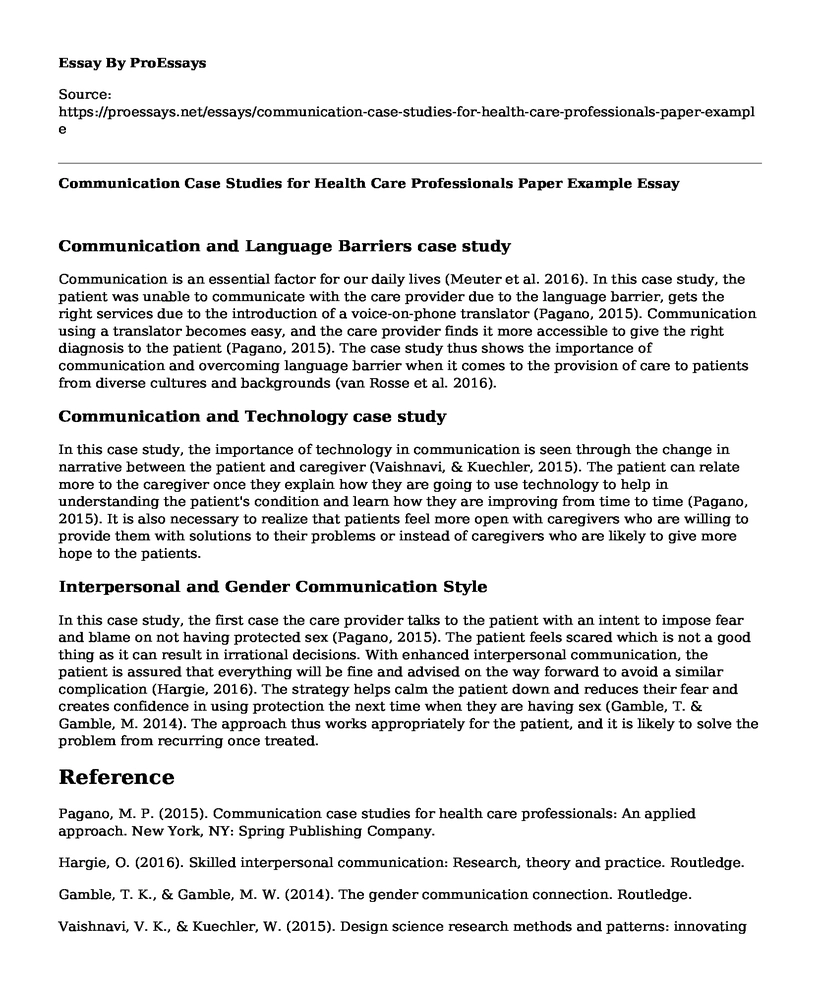Communication and Language Barriers case study
Communication is an essential factor for our daily lives (Meuter et al. 2016). In this case study, the patient was unable to communicate with the care provider due to the language barrier, gets the right services due to the introduction of a voice-on-phone translator (Pagano, 2015). Communication using a translator becomes easy, and the care provider finds it more accessible to give the right diagnosis to the patient (Pagano, 2015). The case study thus shows the importance of communication and overcoming language barrier when it comes to the provision of care to patients from diverse cultures and backgrounds (van Rosse et al. 2016).
Communication and Technology case study
In this case study, the importance of technology in communication is seen through the change in narrative between the patient and caregiver (Vaishnavi, & Kuechler, 2015). The patient can relate more to the caregiver once they explain how they are going to use technology to help in understanding the patient's condition and learn how they are improving from time to time (Pagano, 2015). It is also necessary to realize that patients feel more open with caregivers who are willing to provide them with solutions to their problems or instead of caregivers who are likely to give more hope to the patients.
Interpersonal and Gender Communication Style
In this case study, the first case the care provider talks to the patient with an intent to impose fear and blame on not having protected sex (Pagano, 2015). The patient feels scared which is not a good thing as it can result in irrational decisions. With enhanced interpersonal communication, the patient is assured that everything will be fine and advised on the way forward to avoid a similar complication (Hargie, 2016). The strategy helps calm the patient down and reduces their fear and creates confidence in using protection the next time when they are having sex (Gamble, T. & Gamble, M. 2014). The approach thus works appropriately for the patient, and it is likely to solve the problem from recurring once treated.
Reference
Pagano, M. P. (2015). Communication case studies for health care professionals: An applied approach. New York, NY: Spring Publishing Company.
Hargie, O. (2016). Skilled interpersonal communication: Research, theory and practice. Routledge.
Gamble, T. K., & Gamble, M. W. (2014). The gender communication connection. Routledge.
Vaishnavi, V. K., & Kuechler, W. (2015). Design science research methods and patterns: innovating information and communication technology. Crc Press.
van Rosse, F., de Bruijne, M., Suurmond, J., Essink-Bot, M. L., & Wagner, C. (2016). Language barriers and patient safety risks in hospital care. A mixed methods study. International journal of nursing studies, 54, 45-53.
Meuter, R. F., Gallois, C., Segalowitz, N. S., Ryder, A. G., & Hocking, J. (2015). Overcoming language barriers in healthcare: A protocol for investigating safe and effective communication when patients or clinicians use a second language. BMC health services research, 15(1), 371.
Cite this page
Communication Case Studies for Health Care Professionals Paper Example. (2022, Sep 07). Retrieved from https://proessays.net/essays/communication-case-studies-for-health-care-professionals-paper-example
If you are the original author of this essay and no longer wish to have it published on the ProEssays website, please click below to request its removal:
- Application: Promoting Positive Health Behaviors
- Diagnosis Effects of Chemotherapy for Breast Cancer
- Sports and Its Contribution to Society Today Essay Example
- Research Paper on Planes Crashing
- Essay Example on Military Moms: Sacrificing for Service & Family
- Paper Example on Predicting Consumer Purchasing Habits Using Social Networks
- Essay Sample on Cardiovascular Disease: A Common Risk to 41.5% of Americans







